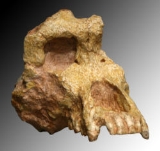
Ouranopithecus macedoniensis
Encyclopedia
Ouranopithecus macedoniensis, sometimes called Graecopithecus freybergi, is a prehistoric hominid species found in Greece
and dated to the late Miocene
. Based on O. macedoniensiss dental and facial anatomy
, it is possible that O. macedoniensis was a dryopithecine. However, O. macedoniensis seems to be more closely related to orangutan
s in subfamily Ponginae
while the most of Dryopithecinae are more closely related to the other great apes
in Homininae
and a few are considered to be outside of the ape
clade altogether. One distinctive trait that Ouranopithecus shares with the humans and other modern African apes is the frontal sinus, a cavity in the forehead. Some investigators consider it possible that O. macedoniensis was the last common ancestor of the great apes and the humans.
. It also had square-shaped orbits. O. macedoniensis may have had a relative large body size.
O. macedoniensiss molar
enamel
cover was fairly thick and had low cusps. Sexual dimorphism is evident by the teeth. The male
O. macedoniensis had large canine teeth with shearing lower premolar
s.
or tubers.
Greece
Greece , officially the Hellenic Republic , and historically Hellas or the Republic of Greece in English, is a country in southeastern Europe....
and dated to the late Miocene
Miocene
The Miocene is a geological epoch of the Neogene Period and extends from about . The Miocene was named by Sir Charles Lyell. Its name comes from the Greek words and and means "less recent" because it has 18% fewer modern sea invertebrates than the Pliocene. The Miocene follows the Oligocene...
. Based on O. macedoniensiss dental and facial anatomy
Anatomy
Anatomy is a branch of biology and medicine that is the consideration of the structure of living things. It is a general term that includes human anatomy, animal anatomy , and plant anatomy...
, it is possible that O. macedoniensis was a dryopithecine. However, O. macedoniensis seems to be more closely related to orangutan
Orangutan
Orangutans are the only exclusively Asian genus of extant great ape. The largest living arboreal animals, they have proportionally longer arms than the other, more terrestrial, great apes. They are among the most intelligent primates and use a variety of sophisticated tools, also making sleeping...
s in subfamily Ponginae
Ponginae
Ponginae is a subfamily in the hominidae family. It contains a number of genera, all but one extinct:*Pongo *†Gigantopithecus*†Sivapithecus*†Lufengpithecus*†Ankarapithecus*†Ouranopithecus*†Griphopithecus...
while the most of Dryopithecinae are more closely related to the other great apes
Great Apes
Great Apes may refer to*Great apes, species in the biological family Hominidae, including humans, chimpanzees, gorillas, and orangutans*Great Apes , a 1997 novel by Will Self...
in Homininae
Homininae
Homininae is a subfamily of Hominidae, which includes humans, gorillas and chimpanzees, and some extinct relatives; it comprises all those hominids, such as Australopithecus, that arose after the split from orangutans . Our family tree, which has 3 main branches leading to chimpanzees, humans and...
and a few are considered to be outside of the ape
Ape
Apes are Old World anthropoid mammals, more specifically a clade of tailless catarrhine primates, belonging to the biological superfamily Hominoidea. The apes are native to Africa and South-east Asia, although in relatively recent times humans have spread all over the world...
clade altogether. One distinctive trait that Ouranopithecus shares with the humans and other modern African apes is the frontal sinus, a cavity in the forehead. Some investigators consider it possible that O. macedoniensis was the last common ancestor of the great apes and the humans.
Morphology
O. macedoniensis had a large, broad face with a prominent supraorbital torusTorus
In geometry, a torus is a surface of revolution generated by revolving a circle in three dimensional space about an axis coplanar with the circle...
. It also had square-shaped orbits. O. macedoniensis may have had a relative large body size.
O. macedoniensiss molar
Molar (tooth)
Molars are the rearmost and most complicated kind of tooth in most mammals. In many mammals they grind food; hence the Latin name mola, "millstone"....
enamel
Tooth enamel
Tooth enamel, along with dentin, cementum, and dental pulp is one of the four major tissues that make up the tooth in vertebrates. It is the hardest and most highly mineralized substance in the human body. Tooth enamel is also found in the dermal denticles of sharks...
cover was fairly thick and had low cusps. Sexual dimorphism is evident by the teeth. The male
Male
Male refers to the biological sex of an organism, or part of an organism, which produces small mobile gametes, called spermatozoa. Each spermatozoon can fuse with a larger female gamete or ovum, in the process of fertilization...
O. macedoniensis had large canine teeth with shearing lower premolar
Premolar
The premolar teeth or bicuspids are transitional teeth located between the canine and molar teeth. In humans, there are two premolars per quadrant, making eight premolars total in the mouth. They have at least two cusps. Premolars can be considered as a 'transitional tooth' during chewing, or...
s.
Diet
Based on the heavily pitted surface of the second molar of Ouranopithecus macedoniensis, it is assumed that its diet consisted of harder foods such as nutsNut (fruit)
A nut is a hard-shelled fruit of some plants having an indehiscent seed. While a wide variety of dried seeds and fruits are called nuts in English, only a certain number of them are considered by biologists to be true nuts...
or tubers.
See also
- Chororapithecus
- AnoiapithecusAnoiapithecusAnoiapithecus is an extinct genus of ape thought to be closely related to Dryopithecus. Both genera lived during the Miocene, approximately 12 million years ago...
- SamburupithecusSamburupithecusSamburupithecus was a primate that lived in Kenya during the middle to late Miocene. The one species in this genus, Samburupithecus kiptalami, is known only from a maxilla fragment dated to 9.5 Ma discovered by Hidemi Ishida and Martin Pickford in 1997. Samburupithecus was approximately...
- Pierolapithecus
- Nakalipithecus
External links
- http://members.tripod.com/cacajao/taxonomy_primata.html
- Mikko's Phylogeny archive

